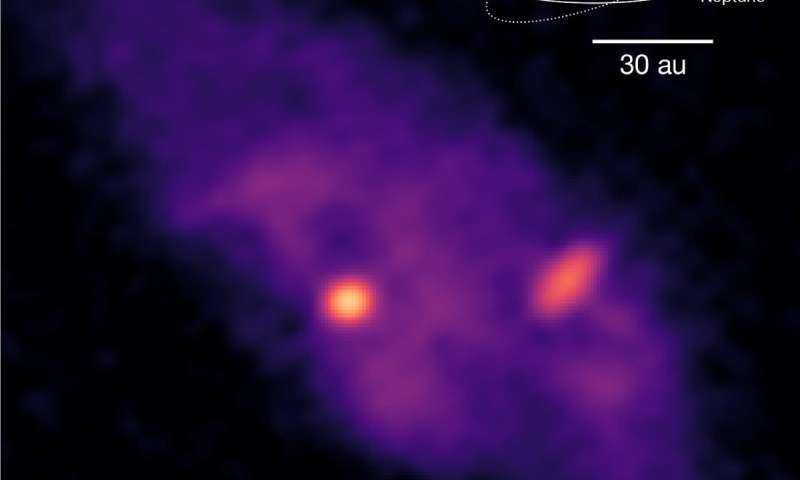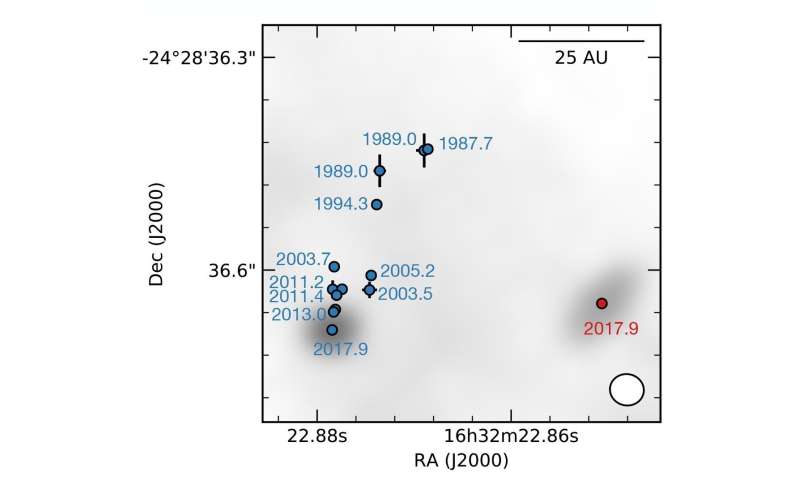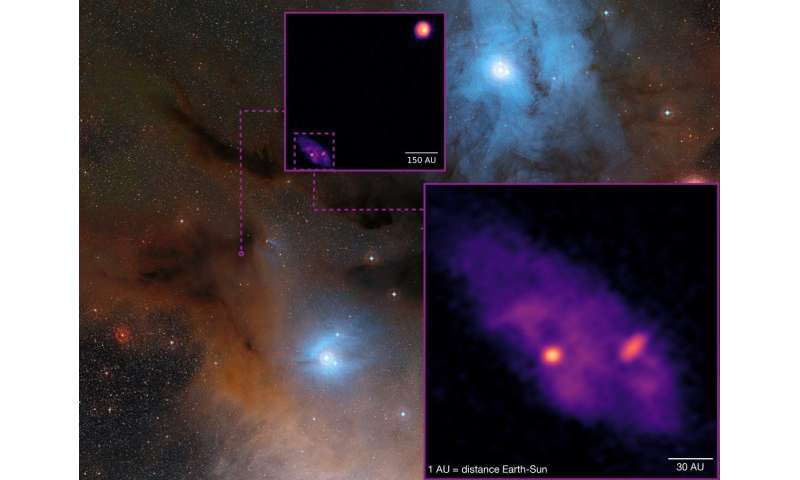JUNE 9, 2020
Zoom into the Ophiuchus molecular cloud, highlighting the star forming system IRAS 16293-2422 with the proto-star B in the upper right corner and the now clearly identified binary proto-stars A1 and A2 on the bottom left. The binary system is shown also in a further zoom-in panel. Credit: MPE; background: ESO/Digitized Sky Survey 2; Davide De Martin
High-resolution observations of a young star forming system clearly unveil a pair of proto-stars at their earliest stages of evolution deeply embedded within the source IRAS 16293-2422 in the Ophiuchus molecular cloud. The team led by the Max Planck Institute for Extraterrestrial Physics used the ALMA interferometer not only to pin down the source configuration, but also to measure the gas and stellar kinematics, determining the mass of the young binary. The two close proto-stars are somewhat heavier than previously thought and they revolve around each other once in about 400 years.
The system called IRAS 16293-2422 is one of the brightest star-forming regions in our neighborhood. It is located in the Ophiuchus molecular cloud at a distance of about 460 light-years and has been widely studied, also because it shows strong emission of numerous complex organic molecules, building blocks of pre-biotic species. However, until now the detailed configuration of the region was unclear, with observations at different wavelengths showing multiple compact sources at slightly different locations. This confusion was due to the large amount of material in front of the nascent proto-stars, expected at these earliest stages of formation.
An international team of astronomers led by the Max Planck Institute for Extraterrestrial Physics (MPE) has now obtained high-resolution radio observations with the ALMA interferometer, which clearly reveals two compact sources A1 and A2 in addition to the well-known proto-star B (see Fig. 1). "Our observations confirm the location of the two close proto-stars and reveal that each is surrounded by a very small dust disk. Both, in turn, are in turn embedded in a large amount of material showing complex patterns" remarks María José Maureira from MPE, the lead author of the study.
 Detailed view of the binary proto-star system with a size comparison to our solar system. The separation between the sources A1 and A2 is roughly the diameter of the Pluto orbit. The size of the disk around A1 (unresolved) is about the diameter of the asteroid belt. The size of the disk around A2 is about the diameter of the Saturn orbit. Credit: MPE
Detailed view of the binary proto-star system with a size comparison to our solar system. The separation between the sources A1 and A2 is roughly the diameter of the Pluto orbit. The size of the disk around A1 (unresolved) is about the diameter of the asteroid belt. The size of the disk around A2 is about the diameter of the Saturn orbit. Credit: MPE
The source A1 has a mass of a bit less than 1 solar mass and is embedded in a small dust disk about the size of the asteroid belt; the source A2 has a mass of about 1.4 solar masses and is embedded in a somewhat larger disk (see Fig. 2). Interestingly, this disk around A2 also appears at an angle compared to the overall orientation of the larger cloud structure, while the disk around the source B—at a much larger distance—is seen face-on, indicating a rather chaotic formation history.
In addition to direct imaging of the dust emission, the team also obtained information on the motion of the gas around the stars through observations of spectral lines of organic molecules, which well trace the high-density region surrounding the discovered binary system. This allowed them to get an independent mass measurement and to confirm that A1 and A2 form a bound pair.

High-resolution observations of a young star forming system clearly unveil a pair of proto-stars at their earliest stages of evolution deeply embedded within the source IRAS 16293-2422 in the Ophiuchus molecular cloud. The team led by the Max Planck Institute for Extraterrestrial Physics used the ALMA interferometer not only to pin down the source configuration, but also to measure the gas and stellar kinematics, determining the mass of the young binary. The two close proto-stars are somewhat heavier than previously thought and they revolve around each other once in about 400 years.
The system called IRAS 16293-2422 is one of the brightest star-forming regions in our neighborhood. It is located in the Ophiuchus molecular cloud at a distance of about 460 light-years and has been widely studied, also because it shows strong emission of numerous complex organic molecules, building blocks of pre-biotic species. However, until now the detailed configuration of the region was unclear, with observations at different wavelengths showing multiple compact sources at slightly different locations. This confusion was due to the large amount of material in front of the nascent proto-stars, expected at these earliest stages of formation.
An international team of astronomers led by the Max Planck Institute for Extraterrestrial Physics (MPE) has now obtained high-resolution radio observations with the ALMA interferometer, which clearly reveals two compact sources A1 and A2 in addition to the well-known proto-star B (see Fig. 1). "Our observations confirm the location of the two close proto-stars and reveal that each is surrounded by a very small dust disk. Both, in turn, are in turn embedded in a large amount of material showing complex patterns" remarks María José Maureira from MPE, the lead author of the study.
 Detailed view of the binary proto-star system with a size comparison to our solar system. The separation between the sources A1 and A2 is roughly the diameter of the Pluto orbit. The size of the disk around A1 (unresolved) is about the diameter of the asteroid belt. The size of the disk around A2 is about the diameter of the Saturn orbit. Credit: MPE
Detailed view of the binary proto-star system with a size comparison to our solar system. The separation between the sources A1 and A2 is roughly the diameter of the Pluto orbit. The size of the disk around A1 (unresolved) is about the diameter of the asteroid belt. The size of the disk around A2 is about the diameter of the Saturn orbit. Credit: MPEThe source A1 has a mass of a bit less than 1 solar mass and is embedded in a small dust disk about the size of the asteroid belt; the source A2 has a mass of about 1.4 solar masses and is embedded in a somewhat larger disk (see Fig. 2). Interestingly, this disk around A2 also appears at an angle compared to the overall orientation of the larger cloud structure, while the disk around the source B—at a much larger distance—is seen face-on, indicating a rather chaotic formation history.
In addition to direct imaging of the dust emission, the team also obtained information on the motion of the gas around the stars through observations of spectral lines of organic molecules, which well trace the high-density region surrounding the discovered binary system. This allowed them to get an independent mass measurement and to confirm that A1 and A2 form a bound pair.

Relative motion of A1 (blue) with respect to A2 (red) overlaid on the ALMA continuum observation. The visual impression that A1 orbits around A2 is confirmed through a detailed analysis of the motion of the proto-stars over a 30-year period. Credit: MPE
Combining their latest observations with data collected over the past 30 years, the team found that the two stars orbit each other once every 360 years at a distance similar to the extent of Pluto's orbit, where the orbit is tilted by about 60° (see Fig. 3). "This is the first time that we were able to derive the full orbital parameters of a binary system at this early stage of star formation," points out Jaime Pineda from MPE, who contributed to the modelling.
"With these results we are finally able to dive into one of the most embedded and youngest proto-stellar systems, unveiling its dynamical structure and complex morphology, where we clearly see filamentary material connecting the circumstellar disks to the surrounding region and likely to the cirbumbinary disk. The small disks are probably still being fed and growing!" emphasizes Paola Caselli, director at MPE and head of the Center for Astrochemical Studies. "This was only possible thanks to the great sensitivity of ALMA and the observations of molecules which uniquely trace these dense regions. Molecules send us signals at very specific frequencies, and, following changes of such frequencies across the region (due to internal motions) one can reconstruct the complex kinematics of the system. This is the power of astrochemistry."
Explore furtherAstronomers observe how two suns collect matter in a binary system
More information: Orbital and mass constraints of the young binary system IRAS 16293-2422 A: arXiv:2005.11954 [astro-ph.SR] arxiv.org/abs/2005.11954
Provided by Max Planck Society
25 shares
Combining their latest observations with data collected over the past 30 years, the team found that the two stars orbit each other once every 360 years at a distance similar to the extent of Pluto's orbit, where the orbit is tilted by about 60° (see Fig. 3). "This is the first time that we were able to derive the full orbital parameters of a binary system at this early stage of star formation," points out Jaime Pineda from MPE, who contributed to the modelling.
"With these results we are finally able to dive into one of the most embedded and youngest proto-stellar systems, unveiling its dynamical structure and complex morphology, where we clearly see filamentary material connecting the circumstellar disks to the surrounding region and likely to the cirbumbinary disk. The small disks are probably still being fed and growing!" emphasizes Paola Caselli, director at MPE and head of the Center for Astrochemical Studies. "This was only possible thanks to the great sensitivity of ALMA and the observations of molecules which uniquely trace these dense regions. Molecules send us signals at very specific frequencies, and, following changes of such frequencies across the region (due to internal motions) one can reconstruct the complex kinematics of the system. This is the power of astrochemistry."
Explore furtherAstronomers observe how two suns collect matter in a binary system
More information: Orbital and mass constraints of the young binary system IRAS 16293-2422 A: arXiv:2005.11954 [astro-ph.SR] arxiv.org/abs/2005.11954
Provided by Max Planck Society
25 shares
 ]
]
No comments:
Post a Comment